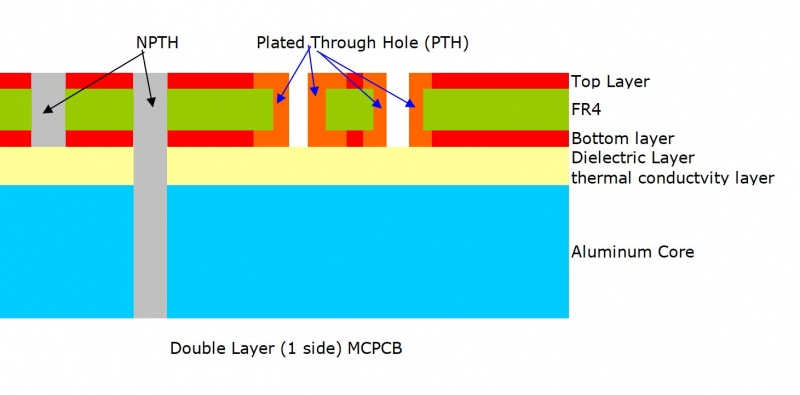What Is a Double-Sided Metal Core PCB?
- Views
- 31 Jan 2024
A double-sided metal core PCB is a printed circuit board composed of two layers of copper material and an aluminum core. However, unlike regular two-layer metal PCB boards, it has one layer of aluminum core material or other metal material such as copper in the middle covered with two copper layers on the top and bottom sides. Many people may wonder: why would a double-sided metal core PCB board be needed? This is because of the location of the copper layers, allowing for more complex circuit designs and higher signal integrity. Therefore, customers will choose double-sided metal core PCBs to meet their higher arrangement of circuit requirements.
Unlike common single-layer metal printed circuit boards, the structure of double-sided MCPCB requires more experience and technology to process the step of lamination of the imaged thermal conductive layer and metal core layer together. However, sometimes, we don’t need to do the extra steps of lamination because our raw material suppliers will provide us with the board material that is already laminated
The structure of a double-sided aluminum-based circuit board is shown in Figure.

Power supply equipment: regulator, DC/AC converter, etc. High heat dissipation of double-sided metal printed circuit boards can prevent the overheat of some parts, which is key to some high-power supply equipment.
Automobile: electronic regulator, ignition, power controller, etc. The excellent heat dissipation performance of double-sided metal printed circuit boards can help the long working of some equipment of automobiles.
double-sided Metal core PCB, Copper core PCBs,
Unlike common single-layer metal printed circuit boards, the structure of double-sided MCPCB requires more experience and technology to process the step of lamination of the imaged thermal conductive layer and metal core layer together. However, sometimes, we don’t need to do the extra steps of lamination because our raw material suppliers will provide us with the board material that is already laminated
The structure of a double-sided aluminum-based circuit board is shown in Figure.

Structure:
1.Circuit layer (Top Side)
The top side of a double-sided metal core PCB comprises a circuit layer, like a traditional single-layer metal core PCB. This layer is typically made of electrolytic copper foil and the circuit patterns are formed through an etching process.2.Thermal Conductivity Layer (Top Side):
Positioned above the metal core layer and under the circuit layer is the thermal conductivity layer. This layer is crucial for efficient heat dissipation and is composed of a prepreg composed of polymer (mainly epoxy resin) filled with high thermal conductivity and high insulation material. The thickness of this layer is determined by its thermal conductivity, with options such as 1w,2w, and 3w.3.Metal Core Layer (Center):
The layer is typically made of aluminum or copper. Common thicknesses include 0.8mm, 1.0mm, 1.2mm, 1.5mm, 1.6mm, 2.0mm, and 3.0mm. The choice of the thickness of the aluminum or copper base, combined with the thermal conductivity of the insulation layer, plays a crucial role in determining the heat dissipation effectiveness of the entire metal core circuit board.4.Thermal Conductivity Layer (Bottom Side):
Similar to the top side, the bottom side of the double-sided metal core PCB also features a thermal conductivity layer. This layer is essential for maintaining uniform heat dissipation across the PCB. The dielectric layer on this side prevents electrical issues and ensures the reliability of electronic components.5.Circuit Layer (Bottom Side):
The bottom side of the double-sided metal core PCB houses the second circuit layer. This layer, like the top circuit layer, is made of electrolytic copper foil and is etched to create the necessary circuit patterns. The arrangement of copper layers on both sides allows for more complex circuit designs and better signal integrity, meeting the higher requirements of certain applications.Advantage:
Higher integration:
Double-sided metal printed circuit boards can achieve higher integration by laying out circuits on both sides, effectively improving the overall space of use and performance.Excellent heat dissipation performance:
Double-sided metal printed circuit boards usually have better heat dissipation performance and can effectively conduct heat to the surface of the metal printed circuit board to improve the heat dissipation effect. This is particularly important for some electronic components with high power density, such as power amplifiers, power modules, etc.Relatively easy manufacturing process:
Compared to some multi-layer metal printed circuit boards, double-sided metal printed circuit boards have a relatively easy manufacturing process, which helps to improve production efficiency.Application:
Computer: CPU board, power supply unit, etc. Because the double-sided boards have two sides to design the circuit that can be realized to adapt to complex circuit requirements. This is very important in computer applications, especially in scenarios that require a high degree of integration such as CPU boards.Power supply equipment: regulator, DC/AC converter, etc. High heat dissipation of double-sided metal printed circuit boards can prevent the overheat of some parts, which is key to some high-power supply equipment.
Automobile: electronic regulator, ignition, power controller, etc. The excellent heat dissipation performance of double-sided metal printed circuit boards can help the long working of some equipment of automobiles.
double-sided Metal core PCB, Copper core PCBs,



